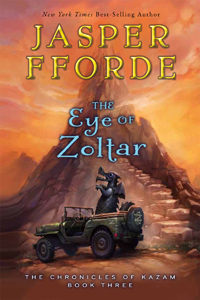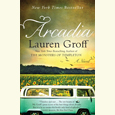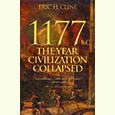A Mildly Subversive YA Fantasy
With his signature brand of silly and smart, Jasper Fforde continues his foray into young-adult literature
With the release of The Eye of Zoltar—the third installment of the Chronicles of Kazam series for young readers—British fantasy-writer Jasper Fforde continues his madcap journey into young-adult literature. Fforde is best known for his seven-volume Thursday Next series for adults, a rollicking otherworldly mashup of detective fiction, science fiction, and classic literature that also manages to include werewolves, Neanderthals, vampires, dodo birds, dinosaurs, time travel, and … well, you name it, and it’s probably in there somewhere. Fforde takes a similar no-holds-barred approach to the Chronicles of Kazam, building an anything-can-happen world in which magic is viewed as a heavily regulated commodity and the paperwork alone required to perform a spell is staggering.
 At the center of the story is the Last Dragonslayer, an intrepid orphan named Jennifer Strange, who serves as an indentured servant to the owner of Kazam Mystical Arts Management. Ever since the Great Zambini mysteriously disappeared, it has been Jennifer’s job to ride herd over the motley crew of washed-up wizards and other supernatural oddballs who reside at Zambini Towers. In this new installment of the series, Jennifer’s responsibilities are mounting: not only is she unexpectedly charged with the real-world education of a spoiled princess, she also finds herself forced by the most powerful wizard of all time to retrieve a legendary jewel (the titular Eye of Zoltar) from the absurdly dangerous Cambrian Empire. But Jennifer and her companions will need more than a recent copy of Enjoy the Unspoiled Charms of the Cambrian Empire without Death or Serious Injury if they are to survive the eighty-six percent fatality rate calculated for their mission.
At the center of the story is the Last Dragonslayer, an intrepid orphan named Jennifer Strange, who serves as an indentured servant to the owner of Kazam Mystical Arts Management. Ever since the Great Zambini mysteriously disappeared, it has been Jennifer’s job to ride herd over the motley crew of washed-up wizards and other supernatural oddballs who reside at Zambini Towers. In this new installment of the series, Jennifer’s responsibilities are mounting: not only is she unexpectedly charged with the real-world education of a spoiled princess, she also finds herself forced by the most powerful wizard of all time to retrieve a legendary jewel (the titular Eye of Zoltar) from the absurdly dangerous Cambrian Empire. But Jennifer and her companions will need more than a recent copy of Enjoy the Unspoiled Charms of the Cambrian Empire without Death or Serious Injury if they are to survive the eighty-six percent fatality rate calculated for their mission.
Fans of Fforde’s Quarkbeast—“a creature often described as a cross between a Labrador and an open knife drawer, with a bit of velociraptor and scaly pangolin thrown in for good measure”—will no doubt enjoy being introduced in this book to honking gazelles, giggle beetles, snork badgers, and the deadly Tralfamosaur, not to mention furniture-emulating slime mold and flesh-eating slugs. But perhaps most exotic is the deadly somnubuvorus: “It looks like a cross between a baobab and a turnip,” Jennifer’s Cambrian guide explains, “and it’s about the size of a phone booth. It’s actually not a plant at all, but a fungus that releases puffs of hallucinogenic spores into the breeze. If you inhale them you become suddenly convinced that being near a somnubuvorus will enlighten you with devastatingly relevant social and political commentary. Once there, you are soon overcome with a sense of listlessness and torpidity, and fall fast asleep.” And then it kills you.
As mayhem and hilarity vie for center stage, quick-minded young readers with a love of the fantastic and a hearty appetite for the completely silly will enjoy following Jennifer and her friends as they journey through a surrealistic landscape and encounter dangerous eccentrics on their way to save the day.
Prior to his appearance at the Southern Festival of Books in Nashville, Jasper Fforde answered questions from Chapter 16 via email.
Chapter 16: In 2009 you said, “Writing without risk is not really writing at all.” With The Last Dragonslayer, how risky did you consider your foray into YA literature, and why did you decide to take the leap?
 Jasper Fforde: The Last Dragonslayer was the fourth of seven books that I wrote while learning to write—I finished it in 1997. My agent suggested I give YA a crack when she reread the novel after a meeting in 2011—she thought it was as fresh now as it was in 1997, with the notion of greed and the 2008 financial meltdown. I try to be as risky as I can with my writing, and as the series has developed, I have attempted to write meta YA: after all, this is a series that takes a mildly subversive look at the magic and dragon and wizard and orphan tropes, so the series is more for YA who know there is a genre to be subverted and will enjoy the idea of their earlier reading gently lampooned. In The Eye of Zoltar I also include a “young person’s guide to insider trading” which I thought a bit daring—and fun, too. Economics is important, and young readers need to know that stuff grownups talk about is not as difficult to understand as they (the grownups) suppose.
Jasper Fforde: The Last Dragonslayer was the fourth of seven books that I wrote while learning to write—I finished it in 1997. My agent suggested I give YA a crack when she reread the novel after a meeting in 2011—she thought it was as fresh now as it was in 1997, with the notion of greed and the 2008 financial meltdown. I try to be as risky as I can with my writing, and as the series has developed, I have attempted to write meta YA: after all, this is a series that takes a mildly subversive look at the magic and dragon and wizard and orphan tropes, so the series is more for YA who know there is a genre to be subverted and will enjoy the idea of their earlier reading gently lampooned. In The Eye of Zoltar I also include a “young person’s guide to insider trading” which I thought a bit daring—and fun, too. Economics is important, and young readers need to know that stuff grownups talk about is not as difficult to understand as they (the grownups) suppose.
Chapter 16: Consider this joke from The Song of the Quarkbeast: “We overheard in passing that the halftime bear-debating event was canceled, as the bear had arrived all mellow and not up for an argument.” Obviously this is much funnier if you have heard of “bear-baiting.” When you’re writing, do you ever worry that younger readers might have trouble following this kind of allusive humor?
Fforde: When writing for YA readers I generally keep the plotting the same—young readers can totally get complex plots—and simply reduce the age of the protagonist, remove a few subplots, and try to minimize the allusion. Young readers like to be treated intelligently, and if you are an avid reader, then “bear-baiting” just might be on your radar. If it is, then you’ve just got a good gag, and there is an intellectual reward there for the attentive reader. If not, then you can either zoom on past, or ask someone. We don’t talk down to kids at Fforde Towers, even if that means missing a few opportunities!
Chapter 16: Your novels commonly feature an unlikely protagonist, oppressed by the stranglehold of commerce and/or government, fighting nobly against the odds toward some kind of freedom or change—in other words, the archetypal “hero’s quest.” Are there examples in your own early reading that influenced you toward this storyline?
Fforde: I have so many influences across so many media—I regard STORY as a tree with many branches that cover radio, TV, comic books, films, and literature. Where to start? Jack Hawkins from Treasure Island is an obvious one, but I could probably list hundreds—from Luke Skywalker to John Trenchard in Moonfleet, David Copperfield and Pip from Dickens, and Gully Foyle from The Stars My Destination. Winnie the Pooh is a constant source of joy, too, as well as The Little Prince and his questions.
Chapter 16: You have said, “The continuous linking of disparate strands is something that I find very enjoyable and quite challenging.” And in each of your series you have created a distinct and elaborate alternate reality—such as the fascinating BookWorld of the Thursday Next series, in which literary characters are revealed to have an existence outside the covers of their books. What is your approach to world building, and how difficult is it to keep it all straight? Are there index cards?
Fforde: No index cards! I tend to use the books themselves as reference, although keeping a series more than three long in my head is quite tricky. World building is great fun, and oftentimes it’s more exciting what one doesn’t put in than what one does. Hinting at a larger world beyond the scope of the story allows the reader to create the bigger story in their head, and I have always maintained that reading is as imaginative a pursuit as writing—often more so. I like to feed that imagination in my readers. If I explained everything to the nth degree, it might become like watching TV—and that’s a far more imaginatively passive form of entertainment.
Chapter 16: How has your experience in film and photography influenced your writing?
Fforde: From a storytelling point of view, I’m not sure being in films for twenty years has helped a great deal, as movies are rarely filmed in the order in which the story is told. What the industry did give me was a lot of travel and the opportunity to meet some very odd people—and it nurtured the love of story, of course, because making movies is like making books: smoke and mirrors and creating reality out of make believe. It’s an absorbing passion, and one that is unlikely to leave me anytime soon!
Chapter 16: Which world will you revisit for your next novel? Shades of Grey fans look forward to a return to the dystopian land of Chromaticia, where social status depends on one’s ability to recognize color. And there have been no further Nursery Crimes volumes, in which nursery-rhyme characters misbehave, since 2006. Or will you create a brand new flight of fantasy?
Fforde: I am currently working on a standalone book—a crime mystery romance—set in a world where humans have always hibernated. My hero is John Fugue, a recently inducted Sleep Marshall who finds himself thrust into the dangerous world of pharmaceutical companies, insomniacs, sleepwalkers, and the possibility of a viral dream that can kill. The sanctity of the sleep state, so long sacrosanct, is about to be rudely bruised.
Chapter 16: Finally, and most importantly, if you could travel through time, where (or more accurately, when) would you go first and why?
Fforde: Probably the meteorite strike that did it for the dinosaurs, or failing that, the opening night of Madame Butterfly. Or back to when I was a young man and made all sorts of stupid mistakes so I could tell myself not to make them—and to start writing earlier.
A graduate of Auburn University, Tina LoTufo has worked as a technical editor at an engineering firm and as an editorial assistant at Peachtree Publishers, where she worked on books by Erskine Caldwell, Will Campbell, and Ferrol Sams, to name a few. She lives in Chattanooga.





